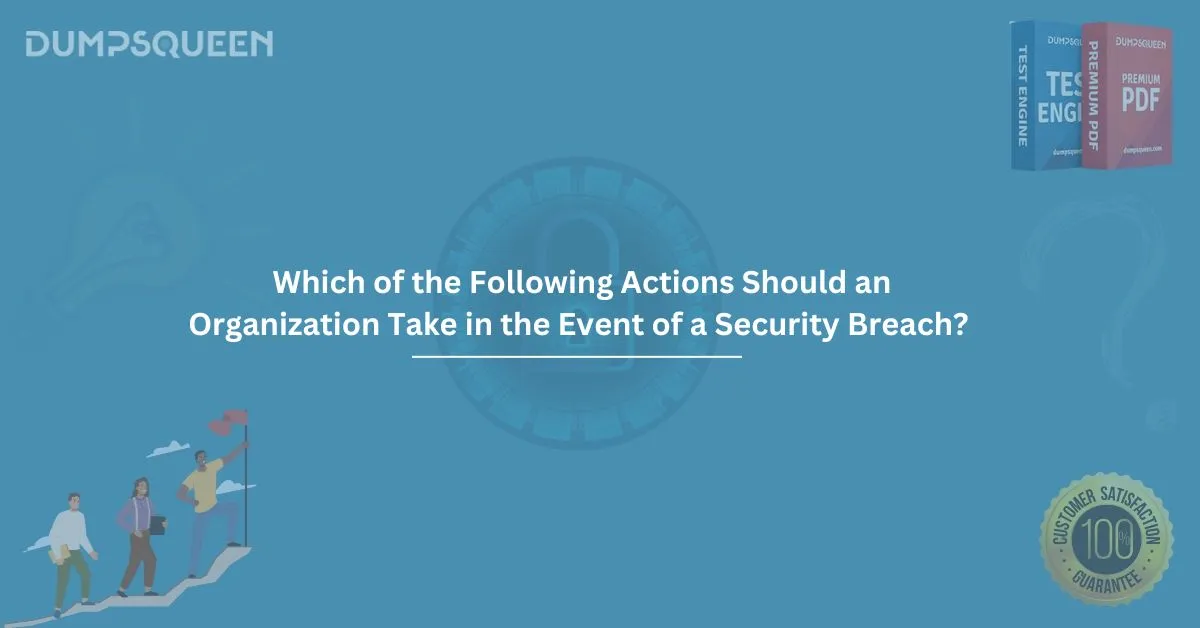In the digital age, organizations are increasingly vulnerable to cyberattacks and data breaches. Whether it's an unauthorized access to sensitive information, a ransomware attack, or a data leak, security breaches pose significant risks to a company’s reputation, operations, and finances. To mitigate the damage and respond effectively to these incidents, businesses must follow a structured approach to handling security breaches. Understanding the necessary steps an organization should take in the event of a breach is critical for minimizing the impact and ensuring compliance with regulatory requirements.
What is a Security Breach?
A security breach is an incident where an unauthorized party gains access to systems, data, or networks. This breach may involve the exposure of sensitive or confidential information, disruption of services, or potential compromise of critical assets. Security breaches can take many forms, including hacking, phishing attacks, data leaks, or even accidental exposure due to human error.
The severity of a security breach depends on the scale, type of data affected, and the organization's preparedness to respond. The consequences can be far-reaching, including loss of customer trust, legal implications, financial losses, and reputational damage. It’s essential to have a comprehensive breach response plan in place to limit the damage and restore normal operations.
Key Actions to Take After a Security Breach
When a security breach occurs, organizations should immediately implement a well-defined incident response plan. The following steps outline the actions that should be taken:
- Detect and Identify the Breach The first action is to detect and identify that a breach has occurred. Early detection is crucial in mitigating the damage caused by the breach. This involves monitoring network traffic, security alerts, and system logs for unusual activities. Many organizations use automated intrusion detection systems (IDS) to help identify potential threats quickly.
Once a breach is detected, it’s essential to verify its authenticity. False alarms can occur, but every alert must be thoroughly investigated. Organizations should have established protocols to escalate suspicious activities to security teams for further analysis.
- Contain the Breach After confirming that a breach has occurred, the next step is to contain it. This involves stopping the unauthorized access or activity to prevent the breach from spreading further. For example, IT teams may isolate compromised systems or networks, disable affected user accounts, or block malicious IP addresses.
Containment should be done as quickly as possible to minimize the scope of the breach. However, the containment measures must be well-coordinated and thorough to ensure that all potential vectors of attack are addressed.
- Eradicate the Threat Once the breach is contained, the organization must focus on eradicating the threat. This step involves removing any malicious software, closing vulnerabilities, and addressing any weaknesses in the system that may have been exploited during the breach. It may involve restoring systems to a secure state, patching known vulnerabilities, and performing system scans to ensure that the breach is fully removed.
Organizations should also conduct a root cause analysis to understand how the breach occurred. This analysis can provide valuable insights into the methods used by the attackers and help strengthen security defenses moving forward.
- Recover and Restore Normal Operations After eradicating the threat, the organization must begin the recovery process. This involves restoring systems, data, and services to their pre-breach state. It’s essential to ensure that the recovery process does not inadvertently introduce new vulnerabilities or issues.
Recovery steps can include restoring from backups, verifying the integrity of restored data, and gradually bringing systems back online. Organizations should prioritize critical services and data during recovery to minimize downtime and disruptions to operations.
- Notify Affected Parties and Report the Incident Depending on the nature of the breach and applicable regulations, organizations may be required to notify affected parties, such as customers, employees, or partners. Regulatory bodies, such as the General Data Protection Regulation (GDPR) or the Health Insurance Portability and Accountability Act (HIPAA), may mandate timely breach notifications to protect individuals' privacy.
In addition to notifying affected parties, organizations must report the breach to relevant authorities. This could include law enforcement agencies, regulatory bodies, or industry-specific oversight organizations. The breach should be documented in detail, and organizations should cooperate with any investigations to help prevent similar incidents in the future.
- Review and Improve Security Posture After resolving the breach, organizations should review their overall security posture to identify any weaknesses or gaps in their defenses. This post-incident review should focus on the lessons learned from the breach and how to strengthen security measures going forward.
Organizations should consider revising their security policies, improving employee training on security best practices, and implementing additional layers of defense, such as multi-factor authentication (MFA), encryption, or advanced threat detection systems. Regular security audits and vulnerability assessments should be conducted to ensure that the organization is adequately protected against future threats.
Preparing for the Next Breach: Proactive Measures
While no organization is entirely immune to security breaches, proactive measures can significantly reduce the likelihood of a breach occurring in the first place. Some key strategies include:
- Employee Training: Regular training on identifying phishing attempts, understanding cybersecurity risks, and practicing good password hygiene can help employees avoid falling victim to attacks.
- Regular Software Updates: Keeping software, operating systems, and applications up to date ensures that vulnerabilities are patched before attackers can exploit them.
- Data Encryption: Encrypting sensitive data ensures that even if attackers gain access, they cannot easily read or use the information.
- Incident Response Plan: Having a well-documented and tested incident response plan ensures that the organization can respond quickly and effectively in the event of a breach.
- Regular Backups: Maintaining regular backups of critical data ensures that an organization can quickly recover in case of a ransomware attack or data corruption.
Conclusion
In the event of a security breach, swift and decisive action is crucial to minimize the impact and protect the organization's assets. By following a structured response plan, organizations can quickly detect, contain, and eliminate threats while ensuring compliance with legal requirements. Proactive security measures, such as employee training and regular system updates, are key to preventing breaches and ensuring the organization's resilience in the face of cyber threats.
Sample Questions and Answers
- What is the first step an organization should take when it detects a security breach?
a) Notify affected parties
b) Eradicate the threat
c) Contain the breach
d) Conduct a post-incident review
Answer: c) Contain the breach
- Which of the following is a proactive measure to prevent security breaches?
a) Relying on default passwords
b) Ignoring security patches
c) Regular software updates
d) Avoiding employee training on cybersecurity
Answer: c) Regular software updates
- What should an organization do after resolving a security breach?
a) Forget about the breach and move forward
b) Notify only internal stakeholders
c) Review and improve security posture
d) Immediately cancel all security measures
Answer: c) Review and improve security posture
- Which regulation requires organizations to notify affected parties in the event of a data breach?
a) HIPAA
b) GDPR
c) Both HIPAA and GDPR
d) No regulation exists for breach notifications
Answer: c) Both HIPAA and GDPR




